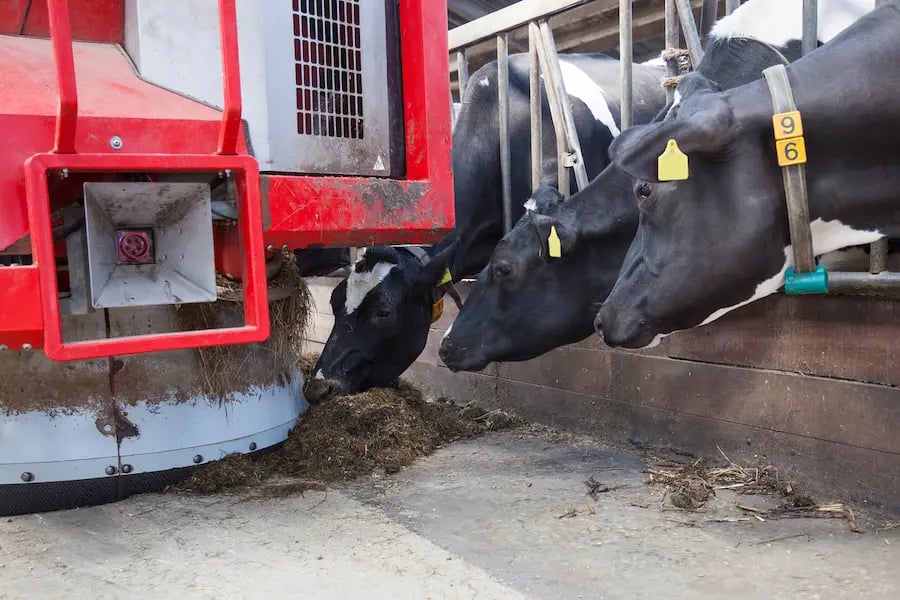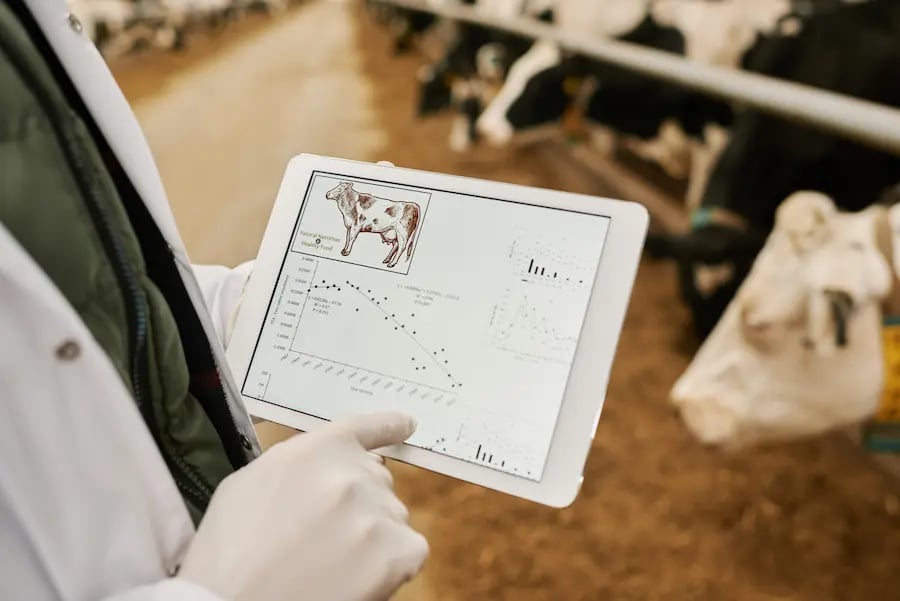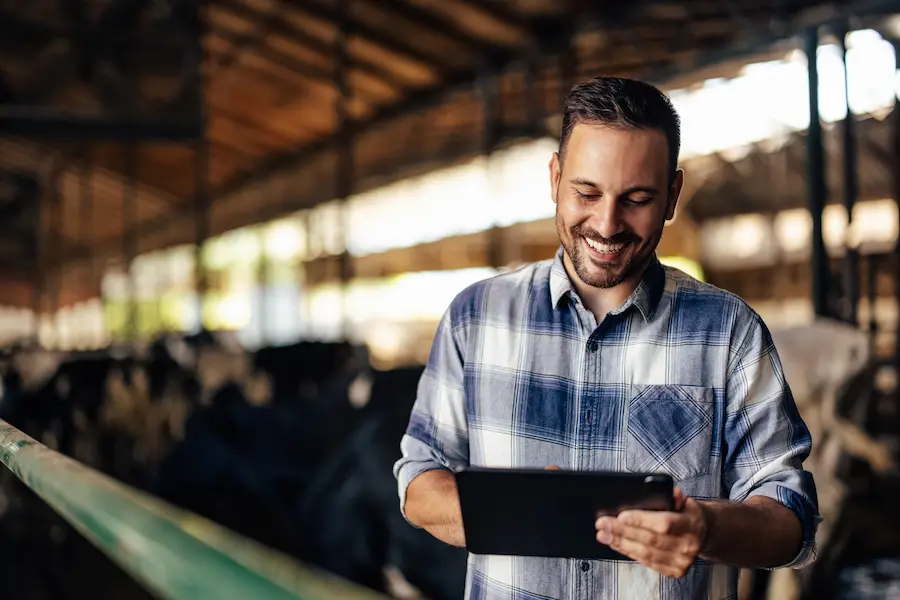Technology is shaping the world around us, and cattle farming is not an exception. From robot milking, invisible fences and digitalized tools like sensors, drones and intelligent feed, the possibilities of associating technology with cattle farming are endless. However, as the volume of data generated by this digitalized toolbox becomes overwhelming, the challenge lies in efficiently integrating data from multiple sources and deriving actionable insights from the wealth of information.
Intelligent Feed: How is technology shaping animal nutrition?
Beginning from the animal, the cattle farming digital transformation starts with monitoring systems like:
- Rumination Collars: A microphone around the cow’s neck that can measure from sound it’s rumination time [1].
- Rumen Bolus Sensor: A sensor inserted inside the rumen that collect pH, temperature, and motion activity [2].
- Milk’s Fat-to-Protein Ratio Monitoring: Parlor system that controls not only the flow, but also nutrition characteristics (like fat, protein and even somatic cell count) of milk, associating an individual cow to this data.
- Individual Water Intake Monitoring.
At the same time smart drones, in-field soil sensors, digital farming platforms and other tools involved in precision farming allows the collection of a lot of data from the pasture, weather, soil, and satellite imagery to become part of the data collected from each farm, allowing a more integrated approach.
Analysing all the data allows machine learning models (like ChatGPT) to: help automatic feeders to make corrections in feed directly; automatic corrections in forage production, adapt and/or add needed supplements or even signal animals that may require veterinary care.

Cattle Farming Digital Transformation –harnessing the power of technology for animal health
Just like monitoring the fat-to-protein ratio can help prevent sub-acute ruminal acidosis in the herd by correcting in advance their feed [3], other technologies can contribute to improve both individual and herd health:
- Reproduction: Artificial intelligence (AI) systems use information about individual female cycle and heat times, through body sensors, to define a more precise moment to do a successful artificial insemination, helping to improve the herd’s reproductive performance [4,5].
- Disease Prevention: Precision livestock farming will make veterinary care more accurate and by consequence more sustainable. Biosensors can monitor not only the herd’s feeding and movement behaviour, but also individual patterns, body temperature and pH. This information can be used to signal animals with ketosis, metritis or mastitis, for example, in an earlier state of the illness, with a better prognosis [6] and allowing a smarter use of resources, like antibiotics.
- Welfare: Technologies still in development are attempting to collect behaviour data to recognize affective states in animals. If this proves to be reliable, it will likely shape the world of farm animal welfare, as it will serve as a way to demonstrate proof of affective states indicative of good welfare, in a faster, less subjective manner that doesn’t interrupt production [7].

Conclusion - From data to action
While the influx of data from diverse sources may seem overwhelming, the solution lies in harnessing the capabilities of AI systems [8]. These systems not only aggregate and collect data comprehensively but also possess the capacity to process it. By conducting cross-analysis between all the information collected by the "digital toolbox", AI transforms complex data into easily interpretable information. This, in turn, empowers farmers and practitioners to make informed decisions, fostering efficiency, and sustainability in cattle farming practices.
References
[1] D. Bar, R. Solomon, Rumination Collars: What Can They Tell Us, 2010.
[2] É. Hajnal, L. Kovács, G. Vakulya, Dairy Cattle Rumen Bolus Developments with Special Regard to the Applicable Artificial Intelligence (AI) Methods, Sensors. 22 (2022). https://www.doi.org/10.3390/s22186812
[3] G. Chládek, The importance of monitoring changes in milk fat to protein ratio in Holstein cows during lactation, 2015. https://www.researchgate.net/publication/27201776
[4] M. Lee, IoT Livestock Estrus Monitoring System based on Machine Learning, Asia-Pacific Journal of Convergent Research Interchange. 4 (2018) 119–128. https://www.doi.org/10.14257/apjcri.2018.09.12
[5] K. Hempstalk, S. McParland, D.P. Berry, Machine learning algorithms for the prediction of conception success to a given insemination in lactating dairy cows, J Dairy Sci. 98 (2015) 5262–5273. https://www.doi.org//10.3168/jds.2014-8984
[6] K. Džermeikaitė, D. Bačėninaitė, R. Antanaitis, Innovations in Cattle Farming: Application of Innovative Technologies and Sensors in the Diagnosis of Diseases, Animals. 13 (2023).https://www.doi.org//10.3390/ani13050780
[7] S. Neethirajan, Affective State Recognition in Livestock—Artificial Intelligence Approaches, Animals. 12 (2022). https://www.doi.org/10.3390/ani12060759
[8] A.M. da Silva, F.K. dos Santos, P.B. Machado, L.G. Berghahn, G.P. de Campos, C.V. de Araújo, S.I. Araújo, F.L. de Menezes, Uso de Inteligência Artificial na Pecuária: Revisão de literatura, Research, Society and Development. 12 (2023) e6612440777. https://www.doi.org/10.33448/rsd-v12i4.40777
About the author
Marcelo Leitão (Researcher FeedInov CoLAB)
Researcher with Veterinary Medicine degree from Vasco da Gama University School in Coimbra, with published work in apiculture, conservation medicine, food safety and parasitology. Work experience in laboratory, wild animal rehabilitation center and small animal clinic. Currently working at FeedInov CoLAB, One Health department working scientific writing, education, and research projects.
Explore author’s articles



Leave your comments here